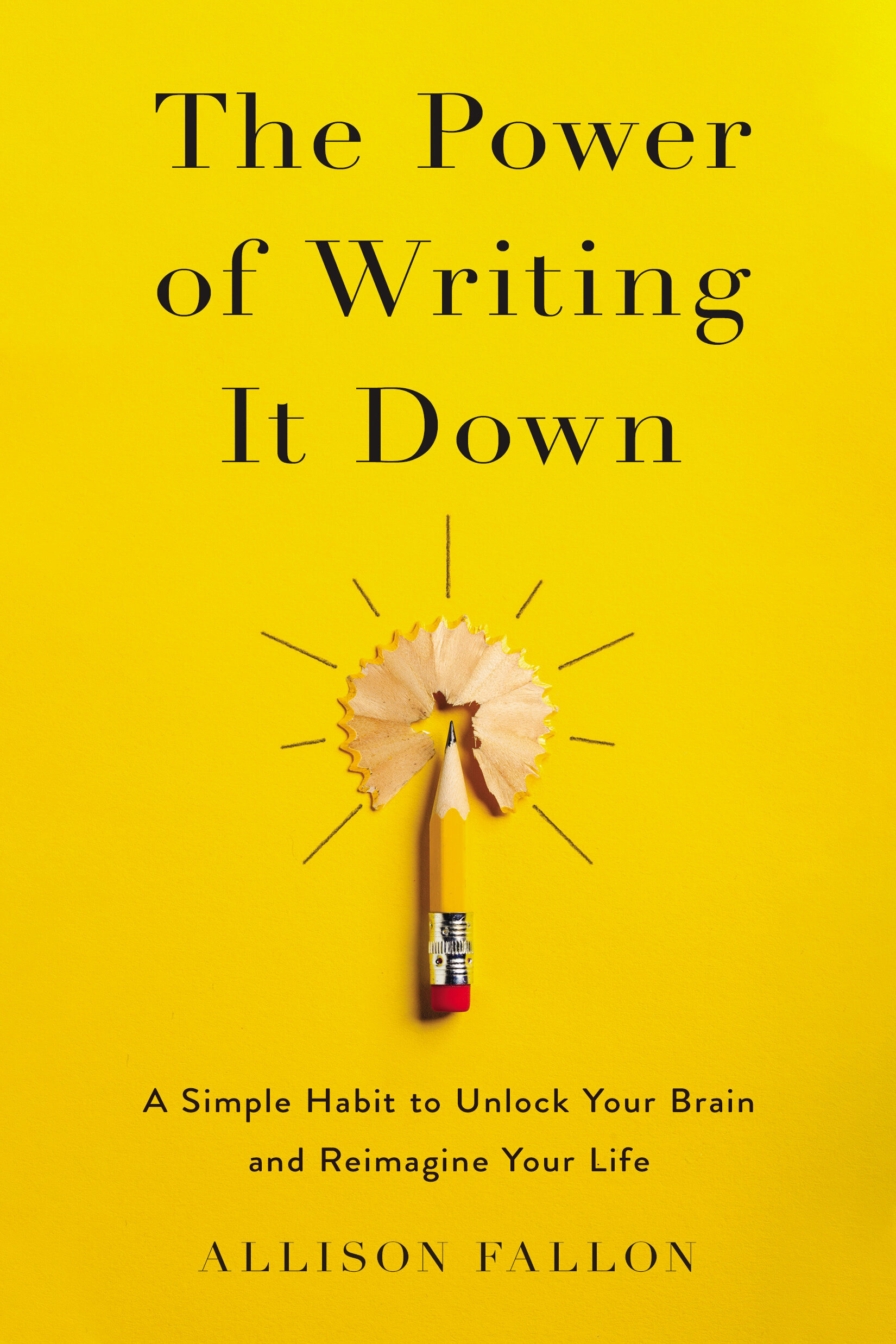Today I have the privilege of sharing an excerpt from my dear friend Ally Fallon’s new book “The Power of Writing It Down.” Ally is the real deal and she is constantly pushing me (and thousands of others) back to the craft of writing. Throughout this book, she laces practicality with hard-earned wisdom when it comes to the daily labor of writing. I loved every part of this book and the excerpt below is one of my favorites! You can order Ally’s new book here. Enjoy!
The reason writing is such a powerful tool for change is because it helps us begin to see things more objectively than we’ve been able to see them before. Speaking doesn’t always do this for us (the limits of talk therapy are now being studied in detail). But when we write, we see things as if they were happening to someone else. We begin to see our thoughts for what they are: a story we are telling ourselves that is not always helpful. And we begin to see the pattern of our feelings for exactly what they represent: memorized sensations in our bodies that predictably happen again and again and again, no matter the details unfolding around us.
Writing helps us untangle these knots. Writing helps us find a path to a new way of life and a whole new set of outcomes.
But I need to address a few important cautions about writing for personal growth. Writing is therapy, for sure. It’s cathartic and an incredibly effective way to metabolize the events of your life—exactly what you’re doing when you go see a therapist. But if you’re going to become your own therapist without any formal training, there are some immediate concerns I’d like you to hold close. Let me dig into these concerns by telling you a story.
A woman named Amy came to one of our workshops because she was feeling stuck and was ready to use writing as a tool to find some forward momentum in her life. I asked her, along with the rest of the group, to identify one area of her life where she would like to see some forward movement. Her response was, with her body.
According to Amy, she’d been yo-yo dieting for years. Amy was tall, blonde, and the kind of woman who, if you saw her walking down the street, would probably catch your eye. She also struck me as the type who was typically immaculately dressed, since even at our workshop, where we spend over half the day up and down off the floor, her hair was perfectly blow-dried, and her nails freshly manicured.
I asked Amy to tell me the facts of the situation. In other words, what was the physical, tangible thing she was trying to change? Amy collected herself before she spoke.
“I’m fat,” she said. The whole room waited.
“Okay, so you’re saying the facts of the situation are that you’re fat?” I asked her, to make sure I understood correctly.
“Yes, that would be the fact.”
I asked Amy if it would be okay if I pushed back a little bit. She agreed. I told her that, to me, the phrase “I’m fat” felt more like a thought about a fact than it did like a fact itself. I waited for a minute. Then, I asked Amy if I could show her why I thought this. She nodded her head, so I turned to the rest of the room.
“How many of you here would call Amy fat? Raise your hands.” Of course, not a single hand in the room went up. Amy looked around the room. This is one way to determine if the “facts” of the situation that you’re trying to change are actually facts, or if they’re just thoughts or feelings: ask other people if they share the same interpretation of your reality.
This is the first pitfall you might run into as you use this process for your own therapy. You might mistake your thoughts or feelings for facts.
Together, Amy and I determined what the fact of the situation actually was. After asking some probing questions, I found out that Amy had recently gained ten pounds. That was the fact. The verifiable, indisputable detail.
Next we turned to the story she was telling herself. She’d written down, “It’s not just the extra weight that bothers me. It’s that when I look in the mirror now, I cringe.”
Ah, cringe. That sounded like a feeling to me. I asked Amy what the thought was that made her feel that cringe. She looked down at her paper.
“I wrote here . . . that I am disgusted with myself,” she said.
“Disgusted is actually a feeling,” I said. “But that doesn’t mean there isn’t a thought mixed in there, too. Could the thought be something like, ‘I’m disgusting’?”
A wave of familiarity and grief washed over Amy’s face. This was a “thought” she’d thought about herself a thousand times, but she had never really stopped to put words to it. Putting words to our thoughts isn’t always easy, but it does give us the power to change them. This was the first time Amy had realized she was thinking such a violent thought about herself all the time.
Having a hard time applying words to your thoughts is a second pitfall you might bump into. You can see how easy it is to do that from reading Amy’s example. When you encounter this obstacle, know this: you are making progress. You are taking a thought that was unconscious and making it conscious
This, by the way, is exactly what you’re doing when you’re working with a gifted therapist. Later in this book, I will give you a few tips on beginning to learn how to do this for yourself.
Am I saying that you should forego therapy (or fire your therapist) in lieu of this much cheaper option called expressive writing? Not exactly. In fact, this is the third pitfall I want to warn you about. There are a handful of great reasons to not take a chance on trying to be your own therapist—for example, if you’re dealing with mental health issues like chronic depression or anxiety, or any kind of trauma that needs to be treated by a professional. This would be like me telling you to build your own sling when you break your arm rather than going to the doctor. That would be irresponsible—for me and for you. Please don’t do that.
What I am telling you is that, even if you’re struggling with your mental health, you can see why expressive writing would be such a great pairing for your work with a mental health professional. Expressive writing, when combined with a therapeutic process, can double or even triple your efforts by helping you multiply the therapeutic process between the times you see your therapist. What if you could begin to internalize the helpful phrases, suggestions, questions and even advice of your therapist, so it’s not just an external resource for you, but an internal one? Writing can help you do this. By using expressive writing in tandem with therapy, I’ve seen clients save thousands of dollars and years of heartache by fast- tracking their progress.
No matter who you are or what brings you to the practice of expressive writing, you do not have to figure things out alone. There are no brownie points for suffering or for getting it right. Your heart and mind are worth the investment, whatever it takes. Writing can be like therapy, but that doesn’t mean it always replaces therapy.
About Allison Fallon
Allison Fallon is the author of The Power of Writing It Down, as well as of Packing Light and Indestructible. She is a speaker and the founder of Find Your Voice, a community that supports anyone who wants to write anything.
She has helped leaders of multi-national corporations, stay-at-home moms, Olympic gold medalists, recovering addicts, political figures, CEOs and prison inmates use the Find Your Voice method as a powerful tool to generate positive change in their lives.
She has lived all over the country in the past decade but now lives in Pasadena, California, with her husband and daughter. You can follow Allison at allisonfallon.com.







LEAVE A LOVE NOTE +